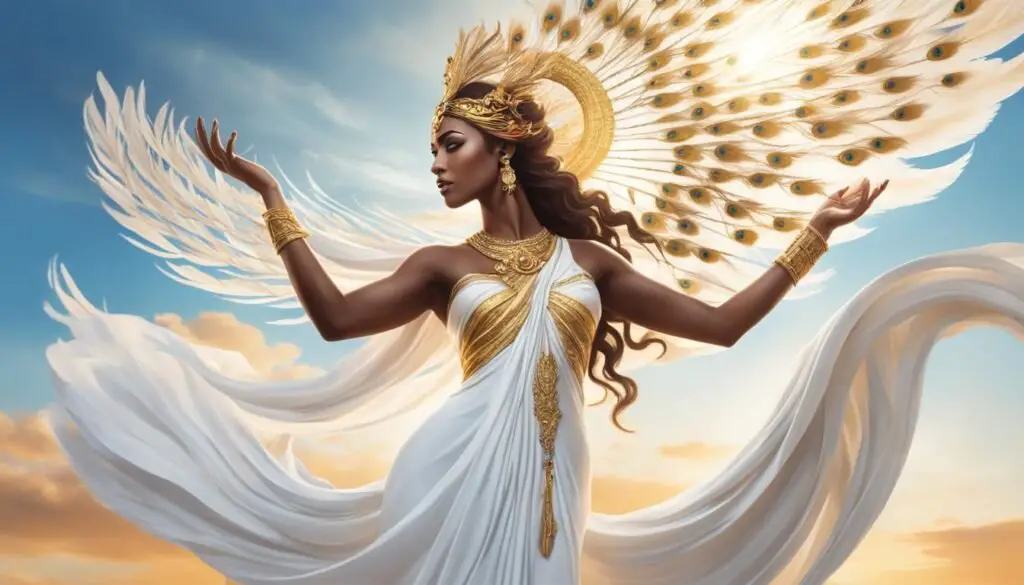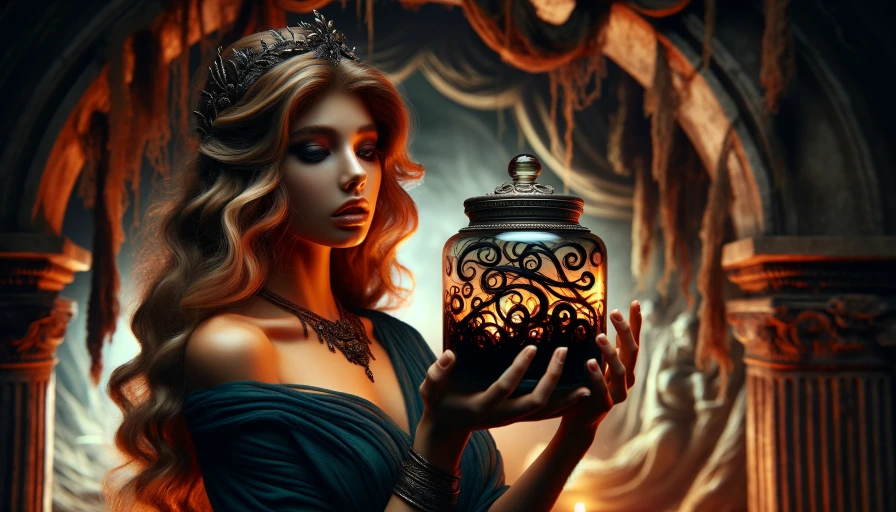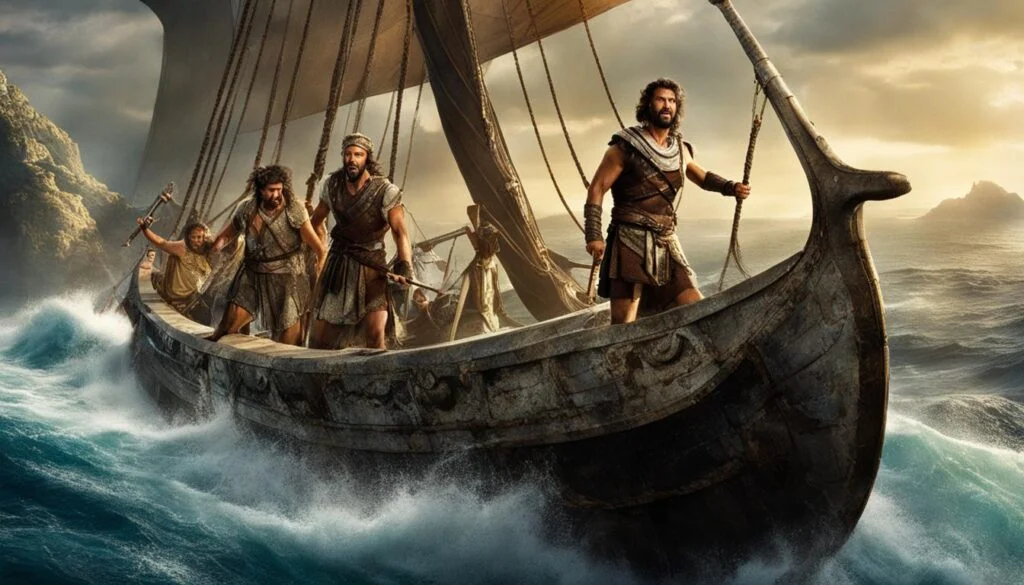Welcome to the fascinating world of Greek mythology, where gods and mortals intertwine in epic tales of love, betrayal, and adventure. In this article, we delve into the captivating story of Io, a beloved princess and nymph who captured the heart of Zeus, the king of the gods.
In Greek mythology, Io’s journey is a testament to the enduring themes of transformation, resilience, and the complexity of relationships between gods and mortals. Her tale is filled with twists, turns, and divine interventions that shaped her destiny and left a lasting impact on Greek mythological lore.
Key Takeaways:
- Io was an Argive princess and Naiad-nymph who was loved by Zeus, the king of the gods.
- Hera, Zeus’ wife, interrupted their tryst and transformed Io into a white heifer.
- Io wandered across Europe and Asia, tormented by a gadfly sent by Hera.
- Io eventually reached Egypt, where Zeus restored her form, and she gave birth to their son Epaphos.
- Io’s descendants ruled Egypt and the East for generations, leaving a lasting legacy in Greek mythology.
The Story of Io in Greek Mythology
Io, an Argive princess and Naiad-nymph, was loved by Zeus. When Zeus transformed her into a white heifer to hide her from Hera’s wrath, the goddess requested the heifer as a gift and appointed Argos Panoptes as its guard. Hermes eventually killed Argos, but Hera retaliated by inflicting Io with a gadfly, causing her to wander across Europe and Asia. Io eventually reached Egypt, where Zeus restored her form, and she gave birth to their son Epaphos. Io’s descendants ruled Egypt and the East for many generations but later returned to Greece.
In this section, we will delve into the captivating story of Io in Greek mythology. Known for her unfortunate transformation and subsequent journey, Io’s tale is filled with twists and turns that highlight the complex relationships between gods and mortals.
According to the myth, Io captured the heart of Zeus, the king of the gods. In order to protect her from the wrath of his wife, Hera, Zeus decided to transform Io into a white heifer. However, Hera was not fooled and demanded the heifer as a gift. To ensure Io’s safety, Hera designated Argos Panoptes, a hundred-eyed giant, as the heifer’s guard.
Determined to free Io, Zeus sent his messenger Hermes to slay Argos. After a long, stealthy pursuit, Hermes succeeded in killing Argos and freeing Io. But Hera, consumed by jealousy, unleashed a gadfly to relentlessly torment Io, causing her to wander across vast lands, both in Europe and Asia.
After enduring years of suffering, Io finally reached the land of Egypt. It was here that Zeus restored her human form, and Io gave birth to their son Epaphos. The lineage of Io’s descendants would go on to rule Egypt and the East for generations to come before eventually returning to Greece.
The story of Io in Greek mythology serves as a testament to the enduring themes of love, jealousy, transformation, and resilience. It showcases the triumph of the human spirit in the face of immense challenges and explores the intricate dynamics between gods and mortals.
Next, we will explore Io’s family and parentage, shedding light on her ancestral roots and connections within the mythological realm.
Io’s Family and Parentage
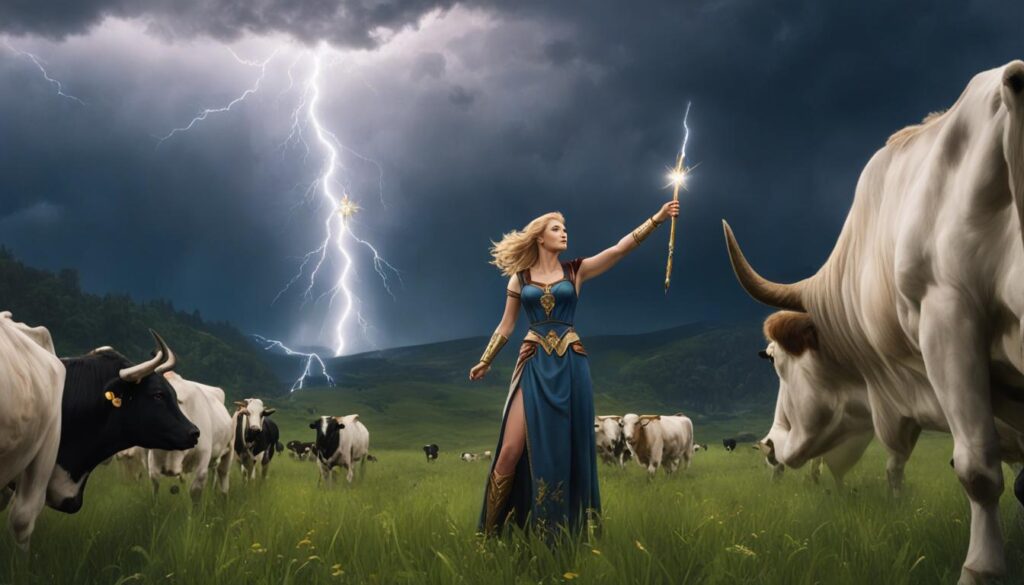
Io, the intriguing figure in Greek mythology, was the daughter of Inachus. Inachus was not only the founder of the worship of Hera in the city of Argos but also an important character in Io’s lineage. While some sources suggest that Io’s mother was Inachus’ wife, the Oceanid nymph Melia, other genealogical accounts propose different possibilities. According to these sources, Io could be the daughter of Iasus or Peiren.
Io’s family heritage is a subject of interest and debate among scholars, showcasing the complexity and variation found in Greek mythology. Regardless of the different interpretations, one thing is certain: Io’s descendants held great prominence in both Egypt and the East, ruling for many generations before eventually returning to Greece.
Strong ties to both her parentage and lineage further emphasize Io’s importance in Greek mythology.
The Myth of Io’s Offspring
Io, the Argive princess and Naiad-nymph, had a number of notable children who played important roles in Greek mythology. After Zeus restored Io’s form in Egypt, she gave birth to her son Epaphos, who would go on to become a significant figure in Greek mythology. The story of Epaphos and his lineage forms an integral part of Io’s mythological journey.
Additionally, there are mentions of Io having a daughter named Keroessa and another son named Harpocrates. These offspring also contributed to the stories and lineage associated with Io, adding further richness and depth to her mythological legacy.
Epaphos: A Key Figure
Epaphos, the son of Zeus and Io, played a significant role in Greek mythology. His birth marked a turning point in Io’s story, as it occurred after her transformation back from a heifer into her human form. Epaphos went on to become the founder of the ancient city of Memphis in Egypt, and he later became the eponymous deity associated with the region.
Keroessa and Harpocrates: Lesser-Known Figures
In addition to Epaphos, Io is said to have had a daughter named Keroessa. While there is less information available about Keroessa compared to Epaphos, she is believed to have had her own significant role and influence in Greek mythology.
Io also had another son named Harpocrates. While his story is not as well-documented as that of Epaphos, Harpocrates is depicted as a god of silence and secrecy in later Hellenistic and Roman traditions, with some connections to fertility and protection.
These children of Io, whether prominent figures like Epaphos or lesser-known ones like Keroessa and Harpocrates, contribute to the broader narrative surrounding Io’s mythological legacy.
Io’s Connection to Egyptian Mythology
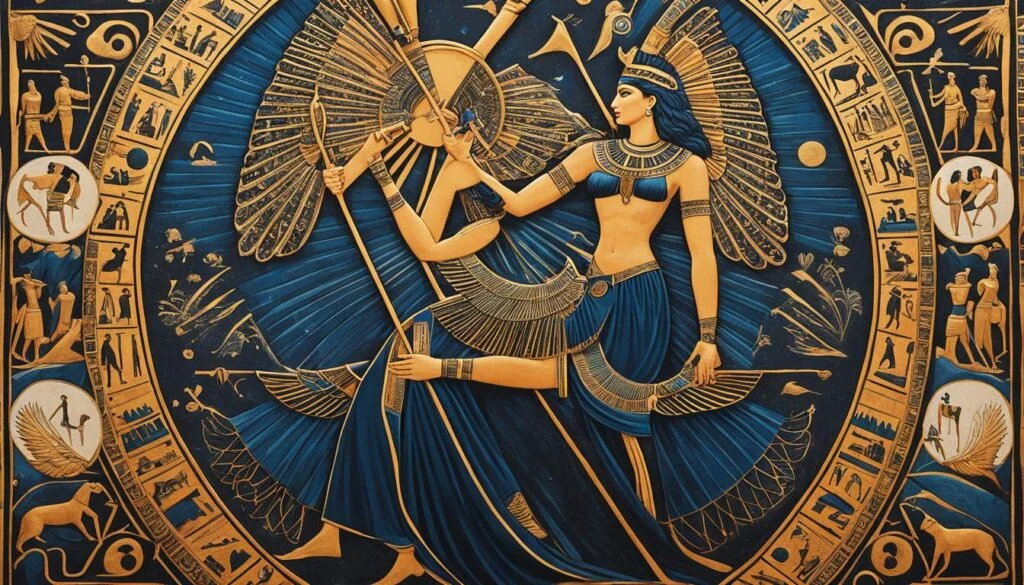
Io, a prominent figure in Greek mythology, shared a fascinating connection to Egyptian mythology. In some instances, Io was identified with the revered Egyptian goddess, Isis. This association added an intriguing layer to Io’s story and expanded her significance within the larger mythological narrative.
Furthermore, Io’s son, Epaphos, became linked to the sacred bull Apis in Egyptian mythology. The connection between the two cultures not only reinforced Io’s role but also highlighted the intermingling of Greek and Egyptian themes.
The blending of these mythological traditions enhanced the depth and complexity of Io’s character, underscoring her enduring impact as a key figure in both Greek and Egyptian mythology.
The Goddess Isis
Isis, the Egyptian goddess often associated with motherhood, fertility, and magic, shared similarities with Io. Both goddesses were known for their transformative qualities and their connections to important male figures in their respective mythologies. This parallel further deepened the association between Io and Isis.
The Sacred Bull Apis
Epaphos, the son of Io, was linked with the revered sacred bull Apis in Egyptian mythology. Apis symbolized strength, fertility, and the divine power of kingship. By linking Epaphos to Apis, Io’s connection to Egyptian mythology gained even greater significance, cementing her status as a noteworthy figure.
Overall, Io’s ties to Egyptian mythology serve as a testament to the far-reaching impact of her story and highlight the fascinating connections between different mythological traditions.
Myths and Legends About Io
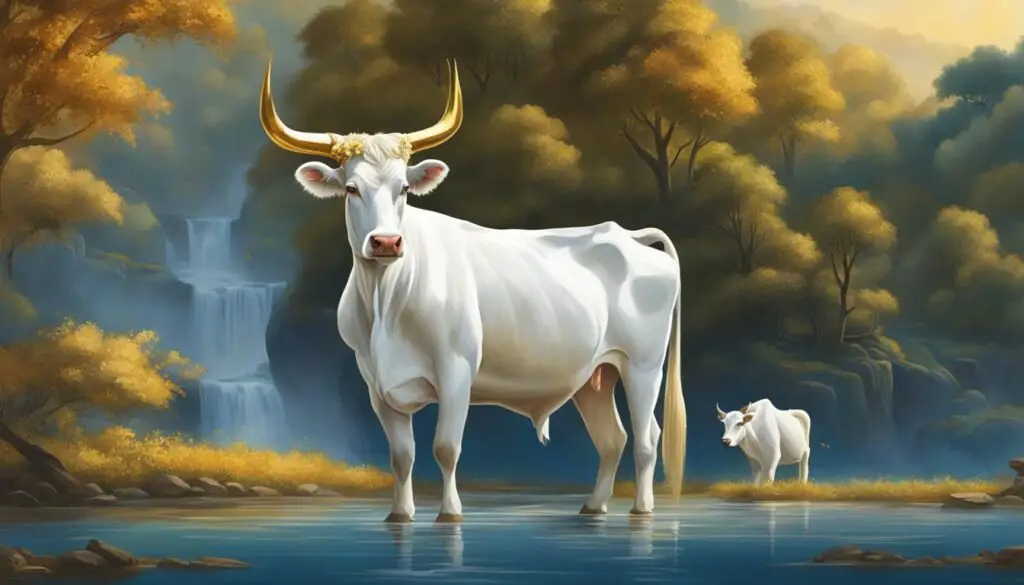
The story of Io in Greek mythology is encased in captivating myths and legends. One of the most renowned tales is Io’s transformation into a heifer, which stands as a testament to the depth of Hera’s jealousy and the great lengths Zeus went to protect her. Throughout her journey, Io became the constant target of Hera’s wrath, symbolized by a persistent gadfly sent to torment her.
These myths and legends shed light on the numerous trials and tribulations faced by Io as a consequence of her relationship with Zeus and his wife, Hera. The metamorphosis into a heifer emphasizes the power dynamics between the gods, the vulnerability of mortal beings, and the intricate workings of divine jealously.
The Transformation of Io
One of the central myths surrounding Io is her transformation into a heifer, dictated by Zeus to conceal her from the wrath of Hera. This strategic decision highlights the intense rivalry between the two goddesses and Zeus’ determination to protect Io. Through her bovine form, Io grappled with a myriad of challenges and hardships, perpetuating a lasting legacy within Greek mythology.
The Persecution by Hera
Hera’s relentless pursuit of Io, manifested through the torment of a gadfly, serves as a prominent aspect of Io’s story. The gadfly’s constant presence and persistent buzzing became synonymous with Io’s eternal suffering and the consequences of her forbidden love affair. Hera’s incessant persecution serves as a reminder of the consequences one may face when caught between the whims of gods.
Io’s journey through these captivating myths and legends navigates the complex dynamics between gods and mortals, and the everlasting consequences of forbidden love. Her story continues to captivate audiences, shedding light on the human condition and the fragility of existence.
Io’s Symbolic Representations
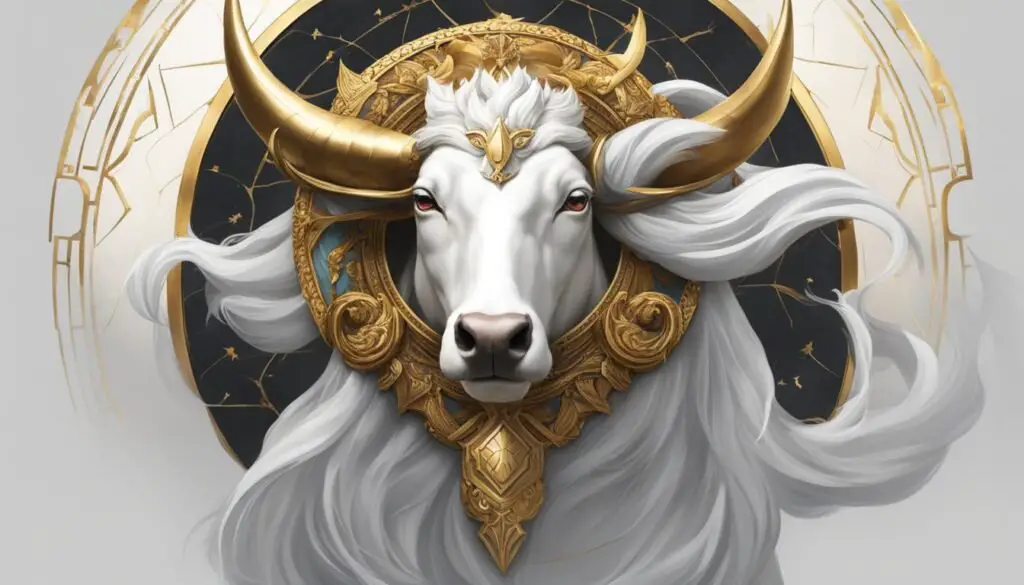
Io, the Argive princess and Naiad-nymph, is often depicted in Greek mythology as a heifer or a woman with bovine features, symbolizing her transformation. These visual representations capture the essence of Io’s mythological journey and the themes of transformation and persecution.
The cow, closely associated with Io, serves as a significant symbol in her story, representing her connection to Zeus and Hera. It symbolizes her transformation into a heifer and the challenges she faced as a result of her relationship with the gods.
Hera’s ongoing torment of Io is often symbolized by a gadfly. This insect, known for its persistence and irritation, represents the relentless pursuit and suffering that Io endured throughout her journey.
These symbolic representations in Io’s story add depth and meaning to her mythological narrative. They highlight the transformation, perseverance, and persecution that Io experienced, making her tale even more resonant and impactful.
Io’s Status as a Heroine in Greek Mythology
Io is revered as a heroic figure in Greek mythology, admired for her unwavering strength and resilience in the face of Hera’s jealousy and the numerous obstacles she encountered on her journey. Despite the challenges thrown her way, Io demonstrated incredible endurance and determination, emerging as a symbol of inspiration for other mythological heroines.
What sets Io apart as a heroine is not only her ability to survive but also her role in shaping the destiny of future generations. Her union with Zeus resulted in the birth of significant descendants, most notably her son Epaphos. This lineage solidified her standing as a celebrated figure in Greek mythology.
Io’s story exemplifies the power of resilience and determination in the face of adversity. Her enduring spirit serves as a testament to the strength of character that can be found in even the most challenging circumstances. Io’s journey resonates with audiences, offering inspiration and hope for those facing their own trials and tribulations.
Throughout Greek mythology, Io’s status as a heroine is celebrated, serving as a reminder of the indomitable human spirit and the power of perseverance. Her tale continues to captivate audiences, reinforcing the timeless themes of courage, resilience, and triumph over adversity.
Io’s Influence on Greek Culture and Art
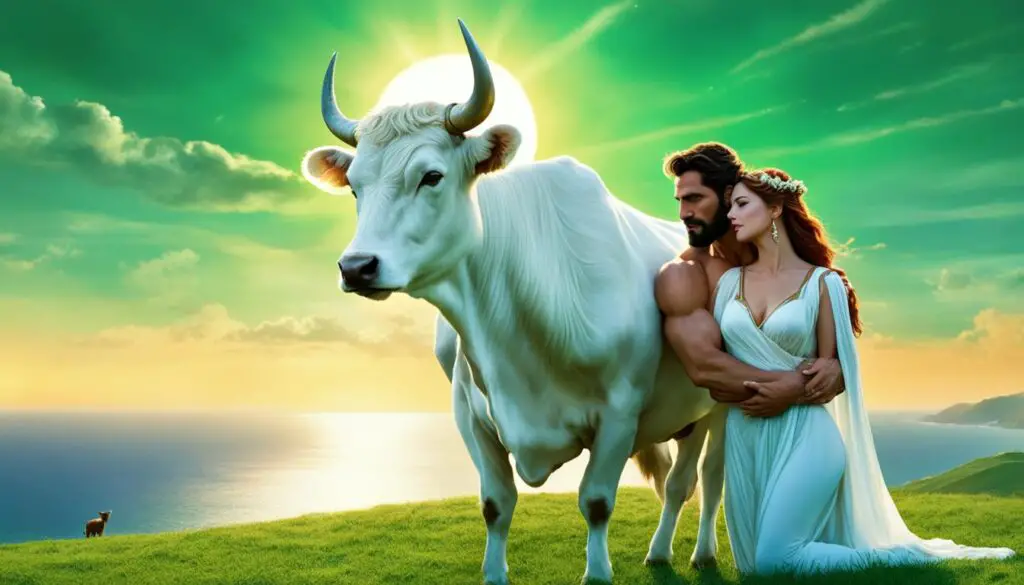
The story of Io has left an indelible mark on Greek culture and art throughout the ages. Artists and writers have drawn inspiration from the captivating tale of Io, incorporating her transformation into a heifer, her encounters with the gadfly, and her epic journey across Europe and Asia into their works.
Io’s mythological narrative has been vividly brought to life through various artistic mediums. Painters have depicted her graceful yet tumultuous transformation in stunning canvases, capturing the essence of her divine connection and the challenges she faced. Writers, too, have woven her story into the fabric of their literary works, entrancing readers with her trials and triumphs.
Io’s myth has become a cherished subject for artists and writers, providing endless creative inspiration and contributing to the rich tapestry of Greek mythology.
The enduring influence of Io’s story is evident in the abundance of artistic interpretations throughout history. Paintings, sculptures, and literary works have immortalized her role as a significant figure in Greek mythology. These artistic expressions not only serve as an homage to Io but also as a testament to the enduring power and impact of ancient myths on human creativity.
Io and Hera’s Rivalry in Greek Mythology
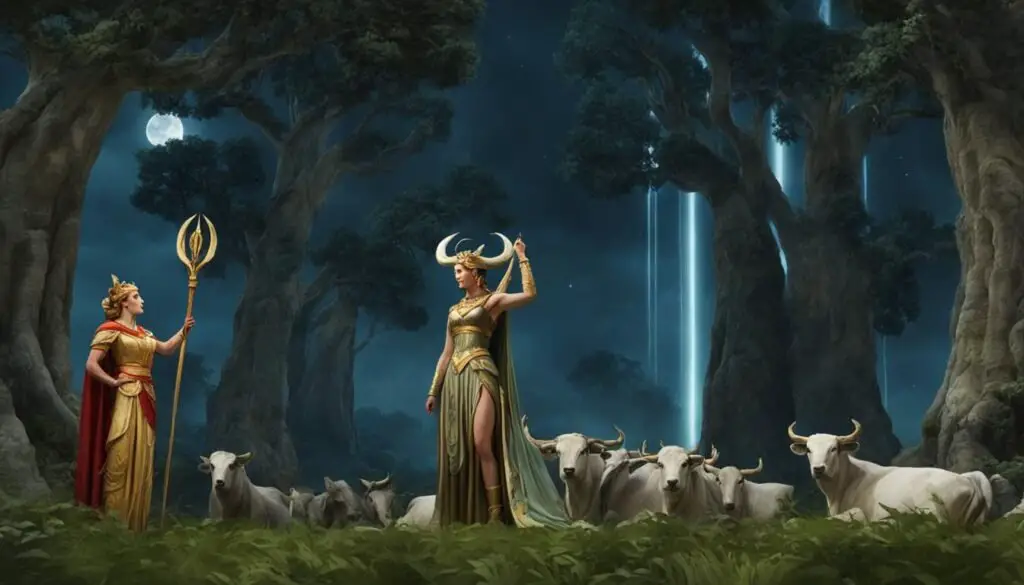
The relationship between Io and Hera represents a classic rivalry in Greek mythology. Hera’s jealousy of Io’s relationship with Zeus led to Io’s transformation and subsequent torment. This rivalry serves as a recurring theme in Greek mythology, highlighting the tension between the mortal women loved by Zeus and his wife Hera.
The conflict between Io and Hera adds depth and complexity to the overall narrative. As Zeus’s lover and a victim of Hera’s wrath, Io embodies the struggle between divine desires and mortal consequences. The story of Io and Hera’s rivalry explores the themes of love, jealousy, power, and loyalty, capturing the imagination of audiences for centuries.
The Transformation of Io
- Io’s transformation into a heifer by Zeus was a desperate attempt to hide her from Hera’s wrath.
- Hera, upon discovering the heifer, claimed it as a gift and appointed Argos Panoptes as its guardian.
- Zeus sent Hermes to kill Argos, but Hera retaliated by inflicting Io with a tormenting gadfly.
The Torment of Io
- Driven by the gadfly, Io wandered across Europe and Asia, enduring immense suffering.
- Her constant state of torment became a symbol of Hera’s jealousy and Io’s resilience.
- Finally, Io reached Egypt, where Zeus restored her human form and they conceived their son, Epaphos.
The rivalry between Io and Hera embodies the complexities of relationships and the consequences of divine affairs. It showcases the struggles faced by mortal women caught in the crossfire of the gods’ desires and the enduring power dynamics between Zeus and Hera. The story of Io and Hera captivates audiences with its themes of love, jealousy, and the human spirit’s resilience in the face of adversity.
Io’s Legacy in Greek Mythology
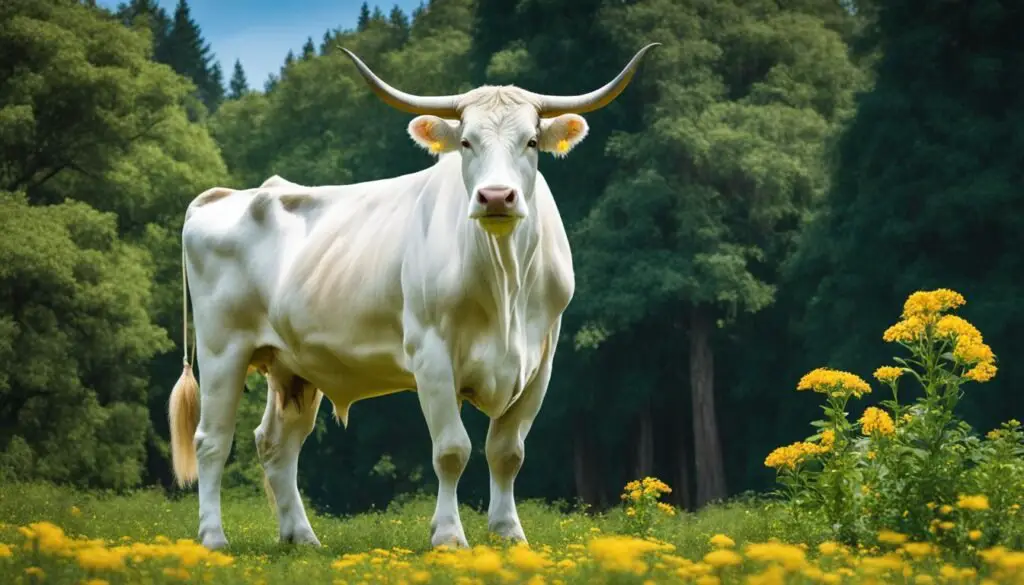
As one of the key figures in Greek mythology, Io’s story extends far beyond her personal journey. Through her descendants, Io’s influence has left an indelible mark on the tapestry of Greek mythology. Heroes, kings, and mythical figures such as Perseus, Cadmus, Heracles, Minos, and Danaus all traced their lineage back to Io. Their stories and achievements contributed significantly to the rich and diverse narratives within Greek mythology.
The impact of Io’s lineage can be observed in various tales and legends. Perseus, the slayer of the Gorgon Medusa, was both a grandson of Io and a hero in his own right. Cadmus, another descendant, was the founder of Thebes and played a pivotal role in the founding of the city. Heracles, renowned for his incredible strength and the completion of his twelve labors, has Io in his ancestral line.
Additionally, the great king Minos of Crete and Danaus, the father of the Danaides, were also among Io’s descendants. Their exploits, including the creation of the Labyrinth and the trials faced by the Danaides, contribute to the overarching narrative of Greek mythology.
Io’s legacy, intertwined with the lives of these impactful figures, has helped shape the enduring legacy of Greek mythology. Their stories continue to captivate audiences, providing a deeper understanding of the complexities of the gods, mortals, and the intricate relationships between them.
Conclusion
The tale of Io in Greek mythology is a captivating story that delves into enduring themes such as love, jealousy, transformation, and resilience. Io’s journey showcases the complex relationships between gods and mortals, and the trials faced by heroic figures like her. Moreover, this mythical narrative emphasizes the lasting impact of mythology on culture and art, with Io’s story inspiring further exploration of Greek mythology.
Throughout her legend, Io’s enduring love for Zeus and Hera’s jealousy led to her transformation into a heifer and subsequent torment by a gadfly. Her unwavering determination and endurance in the face of hardship solidify her as a heroic figure in Greek mythology. The story of Io not only provides insights into the intricate dynamics of divine relationships but also serves as a reminder of the resilience exhibited by mythological heroines.
The legacy of Io extends beyond her personal tale. Her descendants, including renowned figures such as Perseus, Cadmus, Heracles, Minos, and Danaus, have played significant roles in their own stories, shaping the rich tapestry of Greek mythology. The captivating journey of Io and the enduring impact of her lineage continue to captivate audiences and fuel the exploration of the vast realm of Greek mythology.
FAQ
Who is Io in Greek mythology?
Io was an Argive princess and Naiad-nymph who was loved by the god Zeus.
What is the story of Io in Greek mythology?
Io was transformed into a white heifer by Zeus to hide her from Hera’s wrath. She wandered across Europe and Asia, plagued by a gadfly sent by Hera.
Who were Io’s parents?
Io’s father was Inachus, the founder of the worship of Hera in Argos, and her mother may have been Inachus’ wife, Melia, or another figure mentioned in different sources.
Did Io have any children?
Yes, Io gave birth to a son named Epaphos after Zeus restored her form in Egypt. She also had a daughter named Keroessa and another son named Harpocrates.
What is Io’s connection to Egyptian mythology?
Io is sometimes identified with the Egyptian goddess Isis, and her son Epaphos is associated with the sacred bull Apis.
What are some notable myths and legends about Io?
One of the most well-known myths is Io’s transformation into a heifer and her constant pursuit by a gadfly sent by Hera.
What are some symbolic representations of Io?
Io is often depicted as a heifer or a woman with bovine features, symbolizing her transformation. The gadfly is another symbol associated with her.
Why is Io considered a heroine in Greek mythology?
Io’s endurance and resilience in the face of Hera’s jealousy and the challenges she encountered throughout her journey solidify her status as a heroic figure.
How has Io’s story influenced Greek culture and art?
Io’s tale has inspired artists and writers throughout history, who have depicted her transformation and journey. Her story has contributed to the richness of Greek mythology.
What is the significance of the rivalry between Io and Hera?
The rivalry between Io, Zeus’ lover, and his wife Hera represents a classic conflict in Greek mythology and adds depth to the narrative.
What is Io’s legacy in Greek mythology?
Io’s descendants, such as Perseus, Cadmus, Heracles, Minos, and Danaus, played significant roles in their own stories, contributing to the broader tapestry of Greek mythology.
What are the main themes in Io’s story?
Io’s story explores themes of love, jealousy, transformation, and resilience, serving as a lasting reminder of the enduring power of mythology.


